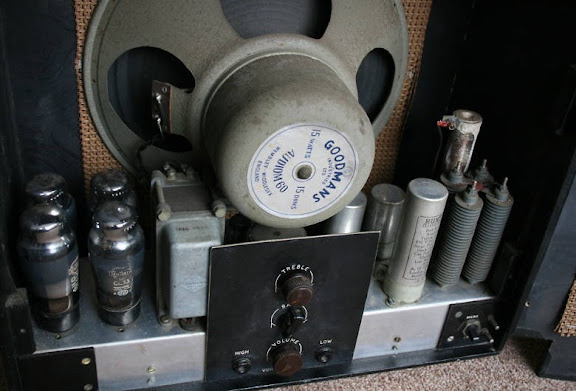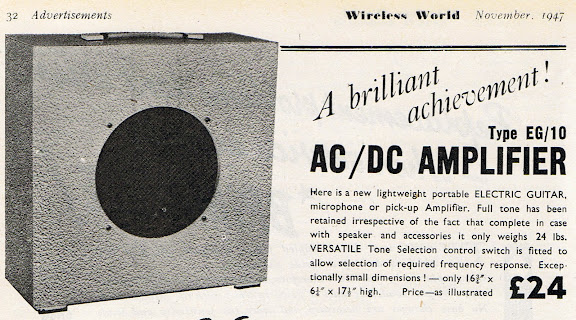It was great to meet like minded enthusiasts at the CTA Mobile Observatory 2010 and I'm confident that great things will happen as a result of our meeting. Thank you very much to everyone who made it happen, particularly Kevin and Pete.
Saturday, December 04, 2010
Changing climates
Tuesday, September 21, 2010
Another distraction
Just acquired this bargain on eBay -
 A 1940s Vortexion EG 20 electric guitar amplifier. Must be the big brother of the EG 10, as advertised in 1947.
A 1940s Vortexion EG 20 electric guitar amplifier. Must be the big brother of the EG 10, as advertised in 1947.The amplifier is complete and very clean so my plans are to first do a minimal restoration to get it working in as close to original state as possible, then convert to safer AC use only with a modern mains transformer and 4 x EL33 to replace the CL33. Though I suppose that 2 x 6L6G would give similar performance.
I'll keep notes on the restoration here
Monday, July 19, 2010
KT44 push-pull valve "quality amplifier"
| From Quality Amplifier |
| From Quality Amplifier |
Saturday, June 26, 2010
Back at the ranch
_132.jpg)
Last weekend I did something a bit different, a first for me. Indeed a first for the UK. The Vintage Computer Festival 2010 at the National Museum of Computing at Bletchley Park.
I took the uniselector clock with me and it was quite a hit, much photographed and now featured on several blogs, here are some -
But I'm at home this weekend enjoying the sunshine, so perhaps tonight I'll put my snapshots from Bletchley online. - Done. More 3D (anaglyphs) of the festival, museum and park on PicasaWeb.
Sunday, April 18, 2010
Stereoscopic Projection by Polarlised Light - demonstrated in 1936

The Wireless World - August 28th, 1936
Stereoscopic Projection by Polarlised Light
Experiments in Manfred von Ardenne's Laboratory
AT this year's Conference of the German Society for Photographic Research, in Berlin, a paper was read by Dr. Haase, of Jena, on new polarising filters and their applications. During the subsequent discussion it emerged that more exhaustive tests and measurements on stereoscopic projection, with the help of the new filters, had been carried on in the 'Manfred von Ardenne Laboratory. At a demonstration at the Lichterfelde laboratory an opportunity was given of seeing the almost startling results given by this solution of the "plastic film " problem. The optical quality of the pictures shown was so good that one felt oneself to be actually standing in the midst of the scene portrayed on the screen.
The idea of obtaining stereoscopic pro-jection by the use of polarised light was, as von Ardenne mentioned at the demonstration, suggested by Anderton a good many years ago. Practical application of the principle, however, failed because at that time there were no suitable polarisers available.
Polarisation Filters
It was not until the appearance of the new " polarisation filters " which have only been on the market a few months that it was possible to produce polarisers in the form of apparently ordinary spectacles, which, however, thanks to the correct orientation of the two "filters " forming the glasses, enable each of the two eyes to pick out only the appropriate image from a composite picture of two images thrown on the screen, each with its light polarised at right angles to the light of the other. Since the image visible to one eye vas photographed by a camera situated a little to the right or left of the camera photographing the image visible to the other eye, the effect on the observer is to give a stereoscopic picture. With the old-fashioned stereoscope, where the two pictures were side by side, the eves were inclined to strain themselves in bringing the two images together. With the present system there is no tiring effect on the eyes, because the two images are merged together on the screen by the projecting apparatus. On removal of the "spectacles," the naked eye sees only one picture (as the photograph shows). This is "flat," with its outlines double.
Completely satisfactory stereoscopic projection, such as was here seen, demands that the state of polarisation of the light should not be changed at the screen. Demonstrations and measurements have shown that this difficulty has been eliminated to such a degree that from all seats of an ordinary cinema the stereoscopic picture can be seen faultlessly.
Saturday, March 27, 2010
Bluetooth A2DP for the Quality Amplifier
In December 2008 I started building a variant of the 1934 Wireless World Quality Amplifier, and by the summer of 2009 I had a pair of these working with a valve preamp based on a Mullard design from the 1950s and a pair of the original Leak Sandwich speakers from the 1960s.
For anyone looking to do the same, here are my notes on getting it working with Windows 7 or Ubuntu.
All very well, but this is 2010 and I seem to listen to music on Spotify more than any other source and radio programmes on iPlayer.
This week I added a Bluetooth A2DP stereo receiver to the amplifier, and I am very impressed by how well it works. Given that these things are almost being given away (mine cost £15) I cannot recommend it enough.
| From gadgets |
Sunday, March 07, 2010
Frakenfone
My latest "gadget hack".
| From gadgets |
Not sure what this 1940s telephone was originally used for, some sort of radio telephone link I guess. Anyway it seemed ideal for conversion to a bluetooth phone. With the handset down the original loudspeaker fitted in the dial aperture is loud enough to be heard clearly in a quiet room. I though some extra amplification might be needed, but I got lucky.
The clear glass bezel was in my junk box and works beautifully to allow the bluetooth earpiece blue/amber LED to be seen.
A simple project, but very pleasing.
Friday, February 12, 2010
Hiding a castle - no magician required
Update - 9th March. Since posting this Okehampton Castle and Okehampton Primary School have been given their correct locations on Google Maps. Well done Google! Oh and it's now easier to make corrections; see new-way-to-edit-places-on-google-maps.
Which looks so very plausible. There's no castle there though! Switch to satellite view and there's nothing to be seen.
Where is it hiding you ask?
Here it is (or yertiz as the locals say) -
Monday, February 08, 2010
Another thing computers will never be able to do...
Allegedly.
This time from a BBC Radio 4 program. http://news.bbc.co.uk/1/hi/world/8495946.stm
Computers will never be able to simulate the "warrior ethos", the mindset and ethical outlook of the professional soldier.
Presumably it's vital to the proper conduct of war and only true soldiers have it.
Sunday, January 10, 2010
Will 3D save consumer tech?

Maybe, maybe not. Best experiment rather than go with guesswork.
Subscribe to:
Posts (Atom)


